Plyometrics, alongside Olympic weightlifting-specific movements (the snatch and clean and jerk), are said to produce similar improvements in muscle power or high-velocity strength compared to traditional resistance training, which is linked to greater improvements in jumping, change of direction, and sprint speed. [1]
Plyometric exercises are characterized by rapid force production by the muscles. Examples of plyometric exercises include explosive jumps, hops, bounds, and skips. Reps and sets for plyometrics are similar to Olympic lifts, that is, relatively few reps (one to five) for multiple sets, with long rest periods so people can move quickly.
With that said, plyometrics aren’t absolutely necessary for most people. Recreational athletes or those exercising for health may be better off spending their time doing traditional resistance training and conditioning unless they prefer incorporating plyometrics for fun. On the other hand, competitive athletes participating in sports that reward improvements in jumping, change of direction, and sprint speed are likely to benefit from their inclusion.
If this is you, then here’s what we recommend: the best upper body plyometric exercises for speed and power, which are the medicine ball “shot” put/chest pass, rotational med ball throw, underhand med ball throw, and explosive push-ups; and the best lower body plyometric exercises — the box jump, broad jump, drop jumps, and single leg hops.
What are the Best Upper-Body Plyometric Exercises?
- Medicine ball “shot” put/chest pass
- Rotational med ball throw
- Underhand med ball throw
- Explosive push-ups
1. Medicine Ball “Shot” Put/Chest Pass
A variation of the traditional shot put, the medicine ball shot put, or chest pass, is done using a medicine ball instead of a metal ball. It primarily targets the shoulders, but also works the chest and the triceps.
The exercise is great for building rotational and upper-body power and coordination. If you’re a volleyball player or a throwing athlete, the medicine ball shot put helps condition the scapular and humeral stabilizers to the eccentric requirements of throwing or hitting a ball.
Equipment-wise, you need a medicine ball to perform this exercise. In fact, adding a medicine ball to any type of training can be beneficial in general. There’s a 2012 study that found a 12-week resistance training program entailing medicine balls can noticeably improve the throwing distances in all applied medicine ball throw tests for young female athletes. [2]
Equipment-wise, you need a medicine ball, of course.
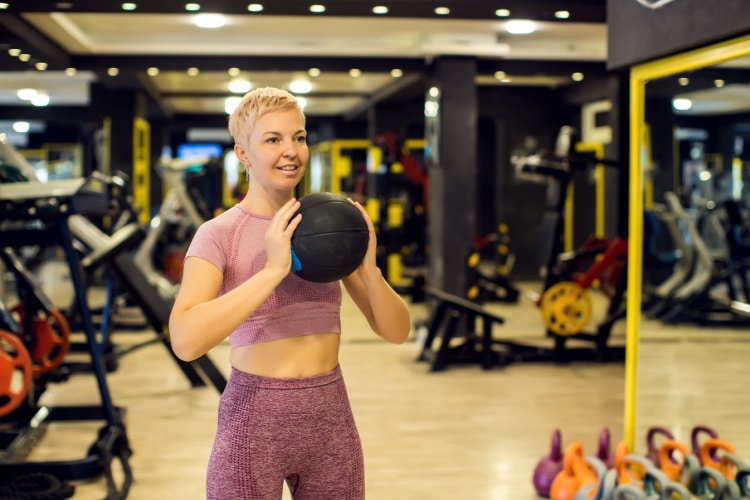
Programming: 3 sets of 6 reps
Weight: Start light, e.g. 10 pounds with an emphasis of throwing the ball quickly and hard
Medicine Ball “Shot” Put/Chest Pass Instructions
- Pick a medicine ball with a suitable weight — if it’s too light, it will hinder your power development; if it’s too heavy, it’ll make it harder for you to maintain the proper form. We recommend picking a medicine ball that you’re capable of throwing 15-25 feet.
- Start by standing with both feet shoulder-width apart and holding the medicine ball at chest height with your hands.
- Step forward with one foot while pivoting on the other one. The idea is for this motion to spin your torso in a way that allows you to face the direction you plan to throw the ball toward.
- Lower your hips and flex your knees as you take a step forward. This will help you create power for the upcoming throw.
- As you push off your back foot, stretch your back arm forcefully and drive the medicine ball forward. To create further momentum and power, use your upper body, hips, and legs.
- Let go of the ball as you follow through with your arm. Aim for maximum distance or height.
- You can either throw the ball against a wall or have a partner throw it back to you.
Keep your core tight — not only will this allow you to throw the ball further, but it also protects your lower back as you drive the medicine ball forward.
2. Rotational Med Ball Throw
Although it looks like an upper body plyometric exercise, the rotational med ball throw works your lower body muscles too. It targets the adductors, glutes, rectus abdominis, internal and external obliques, hip internal and external rotators, forearms, anterior deltoids, upper back, and pectorals.
The rotational medicine ball throw is particularly great for golf, tennis, baseball, hockey, or any sport that requires explosive rotary action. The exercise helps create hip power by leading the athlete into using hip internal and external rotation to draw the necessary power from the ground.
Researchers from Spalding University in Kentucky conducted a study on a college baseball team during a physical assessment entailing three tests to see how they relate to three significant on-field metrics: bat swing, batted baseball, and pitching velocity. The athletic tests included the rotational med ball throw velocity, broad jumps, and lateral-to-medial jump. The findings suggest that it was the rotational med ball throw velocity that best predicted all these on-field metrics. [3]
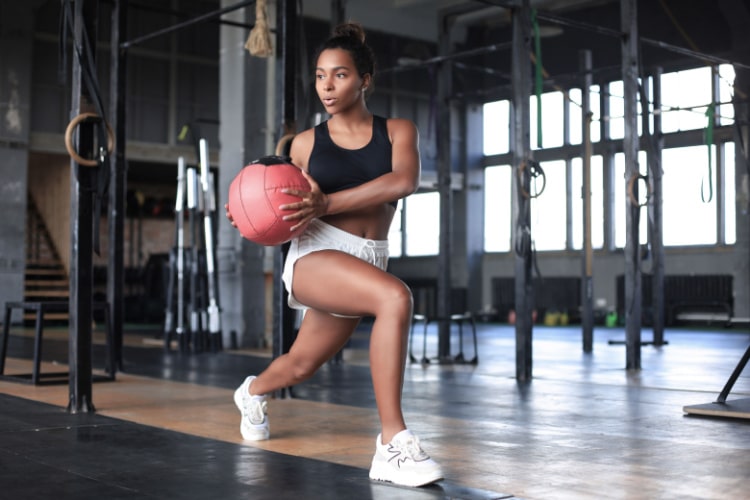
Programming: 3 sets of 15 to 20 reps
Weight: Use light medicine ball, e.g. 5 to 10 pounds with an emphasis of throwing the ball quickly and hard
Rotational Med Ball Throw Instructions
- Begin in an athletic position a few feet away from the wall.
- Push your bottom back and then pull the med ball to your outside hip.
- From this position, rotate your outside foot.
- Throw the ball through the wall, catch it back, and “freeze”.
- Reset by pushing your bottom back.
- Hold the ball along your outside hip and throw again.
- Do the reps on one side, and then switch.
Keep your torso rigid and make sure there’s tension through your core to aid in transmitting force out through your extremities.
3. Underhand Med Ball Throw
The underhand med ball throw is an exercise in which you launch the ball along the front of your body vertically. It primarily targets the trapezius, lateral deltoid, anterior deltoid, gluteus maximus, gluteus medius, semitendinosus, vastus lateralis, vastus medialis, vastus intermedius, but also works the gastrocnemius, biceps femoris, semimembranosus, and rectus femoris.
The exercise helps develop upper-body pulling power for sports like wrestling or rowing. In terms of equipment, you need a medicine ball.
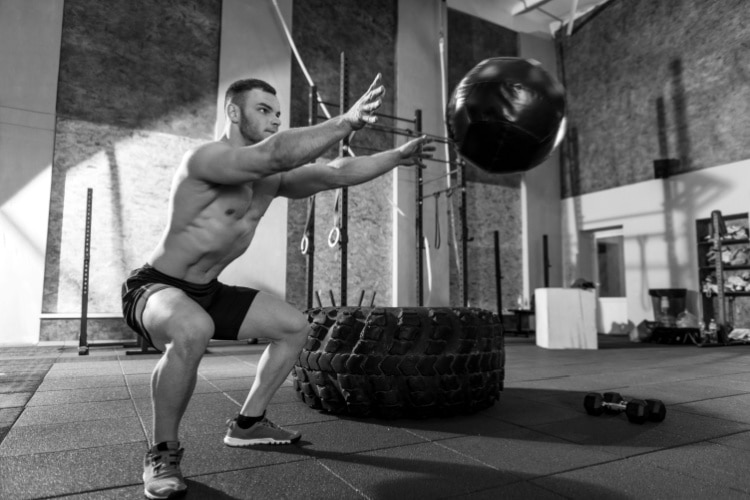
Programming: 3 sets of 6 to 8 reps alternating reps focusing on height and then distance
Weight: Use light medicine ball, e.g. 5 to 10 pounds with an emphasis of throwing the ball quickly and hard
Underhand Med Ball Throw Instructions
- Stand with both feet shoulder-width apart facing the wall and holding the ball between your legs, and squat down.
- Throw the ball up and toward the wall accompanied by a small jump.
- Catch the ball as it bounces back with both feet on the ground and repeat the same motion.
4. Explosive Push-ups
Explosive push-ups target your delts, pecs, and triceps. They also work your abs, forearms, and serratus anterior. They’re an advanced type of exercise that you want to try only if you’re comfortable doing regular push-ups. The idea is to push your body away from the ground with as much effort as possible to maximize the effects.
Although initially created to boost upper-body power, research suggests explosive push-ups might be a valid popular field test of upper-body power and are a useful way to monitor training programs, especially those geared toward improving upper-body power fitness. [4]
You can also modify the intensity level of the push-up by changing the beginning position, that is, switching between the standard and the kneeling position.
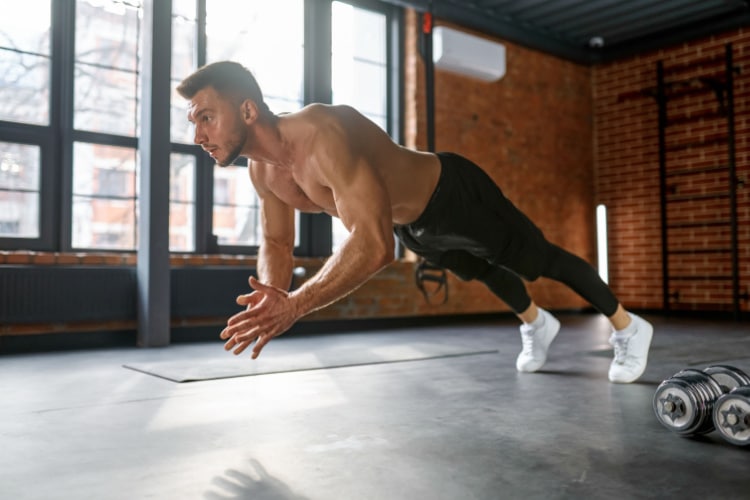
Programming: 3 sets of 5 to 8 reps
Weight: Bodyweight
Explosive Push-ups Instructions
- Get into position for a regular push-up.
- Keep your feet together as you lower your body until your chest almost reaches the ground.
- Stretch your arms in an explosive way so that both hands lift off the floor. If you’re capable of pushing yourself high enough, you may even clap your hands.
- Land on both hands and decelerate the movement when your chest nearly reaches the ground again.
Maintain proper form throughout the exercise — ensure your body is straight and your core engaged. Your hands should be below your shoulders, and your elbows in close proximity to your body.
What are the Best Lower Body Plyometric Exercises?
Lower body plyometric exercises are suitable for any kind of athlete or sport. It could be rugby, basketball, or football, to name a few. While the actual direction might vary from sport to sport, most of them require athletes to produce quick vertical or horizontal movements. Most exercises in this category include jumping, hopping, or bounding. [5]
- Box Jump
- Broad jump
- Drop jumps
- Single leg hops
1. Box Jump
Targeting the quadriceps, glutes, hamstrings, calves, and core, box jumps are an advanced plyometric exercise involving jumping from the floor onto a box or another elevated surface (could also be a step, a chair, or a bench).
Note that thanks to how advanced box jumps are, newbies should start with beginner-friendly variations such as low boxes or steps and move on to using a more elevated surface once they’ve developed solid leg strength and have improved hip mobility and coordination.
If you’ve been doing box jumps for a while, feel comfortable with the exercise’s requirements, and want to step up your game, start using higher boxes/surfaces.
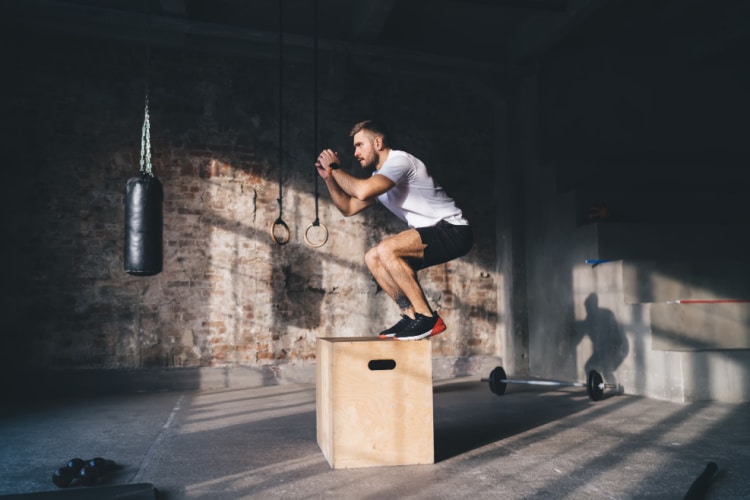
Programming: 3 sets of 6 reps where each set, the height is increased to a max that can be comfortably landed on for all reps
Weight: Bodyweight
Box Jump Instructions
- Stand facing the box — your feet should be within approximately six inches of the side of the box. Keep them hip-distance apart. Your hips and knees are supposed to be bent a bit.
- Flex your knees and press your hips back as you let both arms swing out.
- Jump in the air, swing your arms up and forward, straighten out your knees and hip, and try to jump as high as you can.
- At the peak of your jump, flex your knees and hips to land on top of the box (land with both feet).
- Step slowly off the box and repeat the exercise.
Pick a box that won’t slide around or easily fall over if you kick it. The idea is to land directly on top of the box, and while most sturdy benches/chairs should do the trick, it can still happen that you catch the end of the chair with your foot and have the entire thing fall over while you’re trying to land on it.
2. Broad Jump
A cardiovascular, calisthenics, and plyometrics exercise, broad jumps target the quads alongside the calves, hip flexors, and hamstrings. The exercise entails squatting down and then jumping as far forward as possible to land yet again in a squat position. The exercise is an absolute favorite among athletes and sports enthusiasts as it allows them to sense their power increase over time. That said, broad jumps require not only practice but also proper form to be executed correctly and safely.
As broad jumps tone your lower body starting from the calves to the glutes, they strengthen your entire core and activate the upper body, too.
You’ll often find information on how including a warm-up routine before performing broad jumps may allow you to do them better and more easily, but this isn’t really supported. There’s a research study exploring the effect of 3 warm-up routines on standing broad jump (SBJ) performance in trained and untrained men and women that actually shows the opposite — that warm-up of any type has little effect on jump performance and that maximum strength is strongly related to jumping ability. [6]
Finally, broad jumps are a high-impact exercise, which is why they’re so challenging for your knees and other joints. If you’re dealing with a knee, hip, or ankle injury, avoid the broad jump and stick with modified versions, or simply do squats.
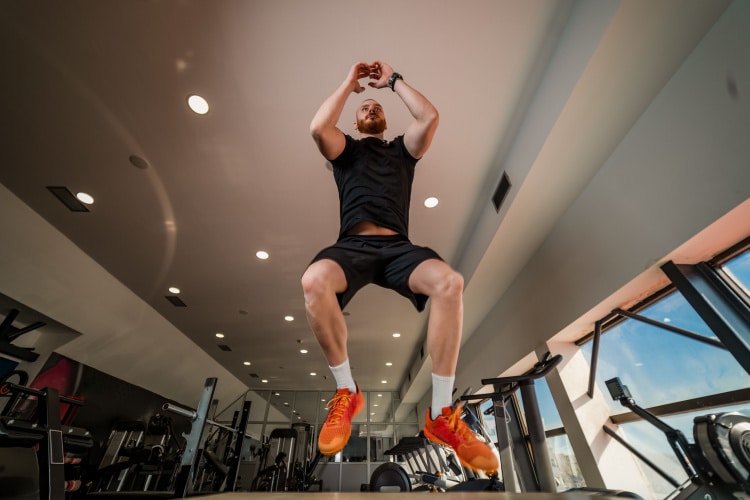
Programming: 3 sets of 6 reps with the intent on jumping the furthest difference on each hop
Broad Jump Instructions
- Stand with your feet shoulder-width apart.
- Squat down by pushing both knees outward as you slowly bend — this will prevent your knees from caving inward.
- As your thighs reach the ground on your descent, swing both arms back and then forward to build momentum.
- Shift your weight onto your feet to lift them off the ground and jump as high and as forward as you can. The more you push, the further you’ll go.
- Flex your knees as you start your descent so that you land in a squat position.
- Return to standing position and repeat the same movements.
As broad jumps require plenty of energy, they can be difficult for novice plyometrics enthusiasts to perform well. For instance, many individuals end up swinging their arms way more than necessary, causing them to lose control during the exercise. So, swing your arms enough to keep the momentum going, but do it with control. You also want to land with your knees bent — don’t lock them.
3. Drop Jumps
Programming: Start with drop “lands”, e.g. stepping off a lower box and progress to hopping off a higher one to the ground. Then finally progress to hopping off a higher box and jumping upon landing on the ground. Emphasize “catching” the ground. Do 3 sets of 6 reps to progressing to the drop jump for the same rep scheme.
In a drop jump, you’re jumping off a box and bouncing back very quickly with minimal floor contact and brief knee bend. The muscles involved include the quadriceps (thigh), hamstrings, glutes (buttocks), and calf muscles.
There are two different techniques used for the descent from the platform: the step-off and the drop-off. The former entails stepping off with one leg, usually the dominant one, while the training leg stays on the platform [7, 8], whereas the latter involves the individual leaning forward so the body’s center of gravity moves out of their base of support and prompts them to fall forward and descend from the platform with both feet leaving the platform at the same time. [9, 10, 11]
While there’s merit to both techniques and both are commonly used, a study comparing the landing and jumping kinetics, inter-limb kinetic symmetry, and jump performance in individuals who used the step-off technique vs. the drop-off technique found the following: the drop-off technique led to less inter-limb kinetic asymmetry compared to the step-off technique. [12]
It’s recommended that athletes do drop jumps on sandy surfaces or from platforms higher than 50cm (19.6 in) to trigger lower body muscle pre-activation and to boost their muscle activation levels in their latency responses after landing. [13]
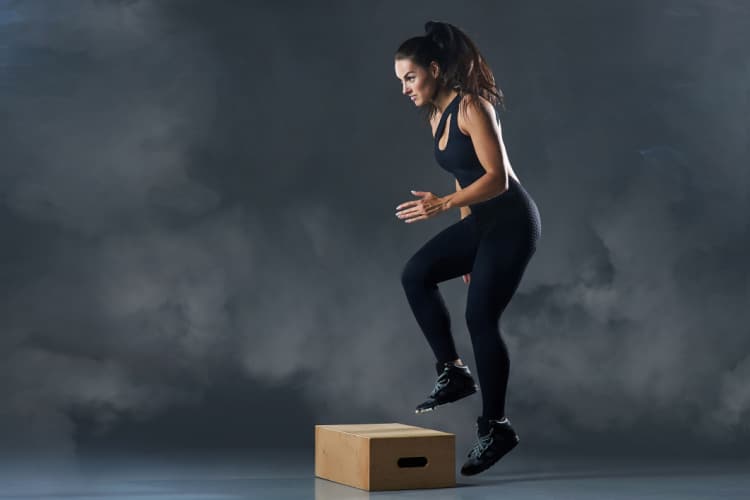
Drop Jump Instructions
- Step onto the box and stand with both feet shoulder-width apart. Your toes should be pointing straight ahead.
- Jump off the box and land softly with both feet. You want to draw your arms back before jumping off the platform and swing them with great force upward as your feet touch the floor to add more force to the movement. Keep your core engaged during the landing phase.
- Step back onto the box and repeat the same movement.
Keep a neutral posture and a balanced elevated chest position during the entire exercise.
4. Single Leg Hops
Programming: 3-4 sets of 5-10 meters of single leg hops. Start with alternating legs, e.g. left leg by 1 rep to right leg by 1-rep and progress to doing all reps on single leg at a time. Emphasis on either max distance or short ground contact times.
A variation of the jump squat, the single leg hop assists with the coordination between ankle extension and knee extension. The exercise primarily works the quads, but it also targets the adductors, glutes, calves, hamstrings, and hip flexors.
A low-level plyometrics training exercise that preps the body for engagement in more advanced movements, the single leg hop is also said to help older men to engage in more explosive workouts.
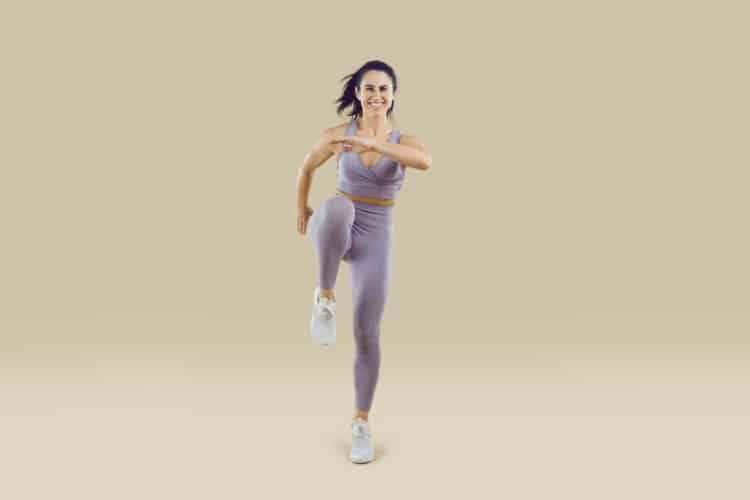
Single leg hop Instructions
- Begin in a standing position with both feet at hip width. Lift your left foot behind you so that you’re standing only on your right leg. Put both hands on your hips to get a sense of whether your hips are level.
- Lift on your toes on your standing leg. Bend your knee and ankle so that you’re able to hop up and down on your standing leg.
- Start hopping on that leg for the desired number of repetitions.
If you have trouble hopping in the same spot, you need to improve your leg strength and slightly slow down the movement.
What Are Plyometrics and When to Use Them in Training?
Plyometrics have been used in training for a long time, but were first name in 1975 by Purdue track and field coach Fred Wilt. [14] Plyometrics can be performed a number of different ways as described above, but the unifying feature is that they are performed quickly and they use the stretch-shortening cycle (SSC)of the muscle fiber to strengthen physical capacity and boost musculotendinous stiffness and power. [15] Plyometrics can be quite fatiguing due to the high amount of force required to move quickly. In general, we recommend performing them towards the beginning of a workout and starting with one or two sessions of two or three plyometric exercises per week. As an individual becomes adapted to the demands of plyometric training, they may increase frequency, volume, and/or intensity.
If you want to increase muscle hypertrophy, however, using plyometrics in your training isn’t the best solution, as plyometrics aren’t that great for muscle hypertrophy, likely due to the reduced eccentric muscle contraction and reduced time under tension.
Plyometrics are predominantly performed via concentric (muscle-shortening) muscular contractions, whereas the paired eccentric (muscle-lengthening) and concentric exercises performed during traditional resistance training are better for increasing muscle size.
They are also performed very quickly, which reduces time under tension compared to slower movements and, in turn, reduces the accumulation of metabolic byproducts that appear to be involved in signaling muscle growth mechanisms in response to mechanical tension. Other high velocity, eccentric-less types of training Olympic lifting appear to preferentially hypertrophy the high-force, high-speed type II muscle fibers and maintain the size of the lower force, low speed type I muscle fibers. By comparison, bodybuilding training increases the size of both type I and type II fibers.
It’s currently unknown if the differences in muscle fiber type hypertrophy is mostly a result of training or due to genetics, e.g. the sport choosing the individual or the individual choosing the sport.
Finally, many studies suggest combining both heavy strength training and plyometrics; certain studies go as far as to suggest that power-related skills are greatly improved thanks to mixing heavy strength training and plyometrics rather than doing either modality alone. [16]
What are the Benefits of Plyometric Exercises?
Plyometrics drive structural adaptations in both the muscle and surrounding tendons, while also signaling neurological adaptations. Together, plyometric training tends to improve high velocity force production (power), rate of force development, change in direction, sprint speed, and structural properties in tendsons, ligaments, and muscles that improve the development and transfer force during movement. [17, 18, 19, 20, 21, 22, 23]
Put simply, there are many reasons why you should incorporate plyometric exercises in your workout routine — so let’s explore the most important ones.
Improved Athletic Performance
Plyometric training is a beneficial physical conditioning method for improving sprint performance, but there are a lot of variables that can affect its results, including the length of the program, the volume of training, and the intensity of the training. To recommend the right amount of training, the velocity and conditioning coach might consider relevant dose-response trends based on expert analysis.
Strength and conditioning specialists may very well incorporate plyometrics into a strength and conditioning program for athletes aiming to achieve a high level of explosive power and athletic performance to complement traditional resistance training. [24] Alternatively, coaches may favor programming Olympic weightlifting variants as well, as they show similar improvements in change in direction and muscular power compared to plyometrics. Still, the data is quite supportive that plyometric training can improve vertical jump height, sprint time, and muscle power in healthy individuals and athletes alike. [25, 26]
Plyometric training has also shown benefit in sports that don’t involve jumping or sprinting, e.g. swimming. For example, one study found that young swimmers who performed plyometrics for 8 weeks in place of sports-specific swimming drills saw an improvement in short-distance swimming performance! [27]
Increased Lower Body Muscle Strength
In general, plyometric training is less likely to improve maximal strength or hypertrophy as much as traditional resistance training can. Plyometric exercises can help improve strength and are best suited for increasing high velocity strength, also referred to as power.
That said, combining plyometrics with other types of training can work well. A 2023 study comparing the effects of strength, plyometric, and combined training on the strength, power, and speed qualities in young male soccer players found that combined training led to improvement in maximal strength, power, and agility. trength, squat, countermovement jump, acceleration, horizontal power, and speed. [28]
Aid in Specific Rehabilitation Cases
Plyometrics can also be used for training designed to prepare an athlete for return to sports. For example, following anterior cruciate ligament (ACL) reconstruction, plyometric exercise can be used during the rehabilitation period. Not only will the gradual exposure to explosive movement better prepare the individual for the demands of sport, it likely also restores some of the speed- and agility-related fitness adaptations lost during the post op period. [29]
Reducing Risk of Injuries
Sports injuries can be defined as reduction in performance due to training and/or competition for a significant period of time, accompanied by subjective pain or discomfort, and a need to modify the training or competition schedule as a result.
Injury risk varies for different sports, with contact sports typically having more injuries than non-contact activities. At present, efforts to reduce injury risk center around improving an individual’s strength and fitness while also progressively exposing them to the specific demands of the sport or activity. Together, these interventions prepare the individual better for what’s being asked of them.
In support of this view, there are studies suggesting that plyometric exercises may reduce injury risk in sport. For example, exercise programs that include plyometric exercises seem to reduce the incidence of ACL injuries compared to workouts without plyometrics. This preventive effect is more prevalent among males, particularly in the prevention of ACL injuries that don’t include contact with other players. [30]
Still, a good strength and conditioning program for athletes should include both plyometrics and traditional resistance training. Much of the data on this type of programming shows benefit in reducing ACL injury risk. [31, 32,33] The exact mechanism of injury risk reduction is unknown, but is thought to be due to improved strength, motor control, and muscular adaptations that improve tolerance to the demands of sport.
Frequently Asked Questions
What plyometrics should I do to jump higher?
To jump higher, consider the following plyometric exercises:
- Box jumps
- Depth jumps
- Squat jumps
- Lateral bounds
- Medicine ball overhead throws
- Bent-over row
Are plyometrics good for fat loss?
Plyometrics haven’t been reliably linked to weight loss.
Strength training boosts muscle mass, lowers the risks of weight regain, and lowers waist circumference by lowering abdominal fat. [34] Engaging in training also seems to boost trainees’ sensitivity to feelings of fullness upon food consumption, potentially assisting with weight loss/maintenance. [35]
The increase in energy demands needs extra oxygen consumption, which is referred to as excess post-exercise oxygen consumption (EPOC). EPOC, or the higher excess post-exercise oxygen consumption from a program which blends strength and hypertrophy is one mechanism that has proven to decrease visceral adipose tissue or belly fat. EPOC also denotes the extra energy used after training to aid the recovery process. [36] Namely, increases in muscle protein synthesis rates in the post-training period are said to denote a noticeable increase in the resting energy expenditure. [37]
On the whole, the energy expenditure during EPOC increases as exercise volume, intensity, and muscle mass grow during resistance and aerobic training. What’s more, EPOC is higher in untrained individuals compared to those who are well trained, as plenty of the high-cost metabolic processes are adapted to within trained subjects. [38, 39] It’s not clear whether EPOC increases the total number of calories consumed daily — for example, the TDEE, total daily energy expenditure — as it hasn’t been tested. Current research illustrates that the overall energy contribution of EPOC to TDEE is quite small. [40]
Another frequently mentioned mechanism is when the increase in muscle mass from resistance training boosts muscle mass, which, in turn, boosts an individual’s resting metabolic rate. The increase in resting metabolic rate is assumed to boost a person’s total daily expenditure, however, this isn’t the case. One kg of muscle uses around 13 calories in a single day, while one kg of fat uses 4.5 calories. [41] To make a noticeable difference in the total daily energy expenditure, a person needs to gain quite a lot of mass. For instance, gaining 10 kg of muscle usually requires years and would boost someone’s total energy expenditure by approximately 85 calories per day.
This brings us to the following conclusion: the mechanism behind lifting weights are much more complicated than what they appear to be and they include changes within the muscular level, endocrine system, the brain, and so on, and lead to improved body composition for those who lift weights regularly.
Conclusion
To sum up, the best upper body plyometric exercises for speed and power are: medicine ball “shot” put/chest pass, rotational med ball throw, underhand med ball throw, and explosive push ups; while those that want to focus on their lower body more should consider the following lower body plyometric exercises: box jump, broad jump, drop jumps, and single leg hops.
If you’re looking for training beyond plyometrics, take a look at some of our more extensive templates. And if you’re in need of a more customized approach, you can always consider a tailor-made program.
Rest assured you’ll be in the hands of certified professionals who not only keep up with the latest sports developments but also keep track of each client’s personal progress and fitness goals.
References
1. Morris, Stephanie J et al. “Comparison of Weightlifting, Traditional Resistance Training and Plyometrics on Strength, Power and Speed: A Systematic Review with Meta-Analysis.” Sports medicine (Auckland, N.Z.) vol. 52,7 (2022): 1533-1554. doi:10.1007/s40279-021-01627-2
2. Ignjatovic, A. M., Markovic, Z. M., & Radovanovic, D. S. (2012). Effects of 12-Week Medicine Ball Training on Muscle Strength and Power in Young Female Handball Players. Journal of Strength and Conditioning Research, 26(8), 2166–2173. https://doi.org/10.1519/jsc.0b013e31823c477e
3. Taniyama, D., Matsuno, J., Yoshida, K., Pyle, B., & Nyland, J. (2021). Rotational Medicine Ball Throw Velocity Relates to NCAA Division III College Baseball Player Bat Swing, Batted Baseball, and Pitching Velocity. Journal of Strength and Conditioning Research, Publish Ahead of Print. https://doi.org/10.1519/jsc.0000000000004148
4. Zalleg, D., Ben Dhahbi, A., Dhahbi, W., Sellami, M., Padulo, J., Souaifi, M., Bešlija, T., & Chamari, K. (2018). Explosive Push-ups. Journal of Strength and Conditioning Research, 1. https://doi.org/10.1519/jsc.0000000000002774
5. Davies, G., Riemann, B. L., & Manske, R. (2015). CURRENT CONCEPTS OF PLYOMETRIC EXERCISE. International Journal of Sports Physical Therapy, 10(6), 760–786.
6. Koch, A. J., O’Bryant, H. S., Stone, M. E., Sanborn, K., Proulx, C., Hruby, J., Shannonhouse, E., Boros, R., & Stone, M. H. (2003). Effect of Warm-Up on the Standing Broad Jump in Trained and Untrained Men and Women. The Journal of Strength and Conditioning Research, 17(4), 710. https://doi.org/10.1519/1533-4287(2003)017%3C0710:eowots%3E2.0.co;2
7. Ball, N. B., Stock, C. G., & Scurr, J. C. (2010). Bilateral Contact Ground Reaction Forces and Contact Times During Plyometric Drop Jumping. Journal of Strength and Conditioning Research, 24(10), 2762–2769. https://doi.org/10.1519/jsc.0b013e3181cc2408
8. Ball, N. B., & Scurr, J. C. (2009). Bilateral Neuromuscular and Force Differences During a Plyometric Task. Journal of Strength and Conditioning Research, 23(5), 1433–1441. https://doi.org/10.1519/jsc.0b013e3181a4e97f
9. Ford, K. R., Myer, G. D., Smith, R. L., Byrnes, R. N., Dopirak, S. E., & Hewett, T. E. (2005). Use of an Overhead Goal Alters Vertical Jump Performance and Biomechanics. The Journal of Strength and Conditioning Research, 19(2), 394. https://doi.org/10.1519/15834.1
10. Almonroeder, T. G., Kernozek, T., Cobb, S., Slavens, B., Wang, J., & Huddleston, W. (2018). Cognitive Demands Influence Lower Extremity Mechanics During a Drop Vertical Jump Task in Female Athletes. Journal of Orthopaedic & Sports Physical Therapy, 48(5), 381–387. https://doi.org/10.2519/jospt.2018.7739
11. Doherty, C., Bleakley, C., Hertel, J., Sweeney, K., Caulfield, B., Ryan, J., & Delahunt, E. (2014). Lower extremity coordination and symmetry patterns during a drop vertical jump task following acute ankle sprain. Human Movement Science, 38, 34–46. https://doi.org/10.1016/j.humov.2014.08.002
12. Wilder, J. N., Riggins, E. R., Noble, R. A., Lelito, C. M., Widenhoefer, T. L., & Almonroeder, T. G. (2021). The effects of drop vertical jump technique on landing and jumping kinetics and jump performance. Journal of Electromyography and Kinesiology, 56, 102504. https://doi.org/10.1016/j.jelekin.2020.102504
13. Peng, H.-T., Chang, H.-K., Chen, H.-W., Huang, Tsung-I., & Chen, H. (2023). Neuromuscular Changes in Drop Jumps on Different Common Material Surfaces with Incremental Drop Heights. Applied Sciences, 13(8), 5123. https://doi.org/10.3390/app13085123
14. Davies G, Riemann BL, Manske R. CURRENT CONCEPTS OF PLYOMETRIC EXERCISE. Int J Sports Phys Ther. 2015 Nov;10(6):760-86. PMID: 26618058; PMCID: PMC4637913.
15. Dick, F. W. (2014). Sports training principles. Bloomsbury.
16. Adams K, O’Shea JP, O’Shea K, Climstein M. The effect of six weeks of squat, plyometric and squat-plyometric training on power production. J. Appl. Sport Sci. Res. 1992; 6:36-41.
17. Hill, J., & Leiszler, M. (2011). Review and Role of Plyometrics and Core Rehabilitation in Competitive Sport. Current Sports Medicine Reports, 10(6), 345–351. https://doi.org/10.1249/jsr.0b013e31823b3b94
18. Holcomb WR Kleiner DM Chu DA. Plyometrics: Considerations for safe and effective training. Strength Cond. 1998;20(3):36‐39.
19. Jarvis, M. M., Graham-Smith, P., & Comfort, P. (2016). A Methodological Approach to Quantifying Plyometric Intensity. Journal of Strength and Conditioning Research, 30(9), 2522–2532. https://doi.org/10.1519/jsc.0000000000000518
20. E, S.-S. de V., B, R., & Ru, N. (2010, September 1). Does Plyometric Training Improve Strength Performance? A Meta-Analysis. Journal of Science and Medicine in Sport. https://pubmed.ncbi.nlm.nih.gov/19897415/
21. Vissing, K., Brink, M., Lønbro, S., Sørensen, H., Overgaard, K., Danborg, K., Mortensen, J., Elstrøm, O., Rosenhøj, N., Ringgaard, S., Andersen, J. L., & Aagaard, P. (2008). Muscle Adaptations to Plyometric vs. Resistance Training in Untrained Young Men. Journal of Strength and Conditioning Research, 22(6), 1799–1810. https://doi.org/10.1519/jsc.0b013e318185f673
22. Wilson, G. J., Murphy, A. J., & Giorgi, A. (1996). Weight and Plyometric Training: Effects on Eccentric and Concentric Force Production. Canadian Journal of Applied Physiology, 21(4), 301–315. https://doi.org/10.1139/h96-026
23. Wilson, J. M., & Flanagan, E. P. (2008). The Role of Elastic Energy in Activities with High Force and Power Requirements: A Brief Review. Journal of Strength and Conditioning Research, 22(5), 1705–1715. https://doi.org/10.1519/jsc.0b013e31817ae4a7
24. Sáez de Villarreal, E., Requena, B., & Cronin, J. B. (2012). The Effects of Plyometric Training on Sprint Performance: a Meta-Analysis. Journal of Strength and Conditioning Research, 26(2), 575–584. https://doi.org/10.1519/jsc.0b013e318220fd03
25. Kons, R. L., Orssatto, L. B. R., Ache-Dias, J., De Pauw, K., Meeusen, R., Trajano, G. S., Dal Pupo, J., & Detanico, D. (2023). Effects of Plyometric Training on Physical Performance: An Umbrella Review. Sports Medicine – Open, 9(1). https://doi.org/10.1186/s40798-022-00550-8
26. Silva, A. F., Clemente, F. M., Lima, R., Nikolaidis, P. T., Rosemann, T., & Knechtle, B. (2019). The Effect of Plyometric Training in Volleyball Players: A Systematic Review. International Journal of Environmental Research and Public Health, 16(16), 2960. https://doi.org/10.3390/ijerph16162960
27. Sammoud, S., Negra, Y., Chaabene, H., Bouguezzi, R., Moran, J., & Granacher, U. (2019). The Effects of Plyometric Jump Training on Jumping and Swimming Performances in Prepubertal Male Swimmers. Journal of Sports Science & Medicine, 18(4), 805–811. https://pubmed.ncbi.nlm.nih.gov/31827366/
28. Oliver, J. L., Akhilesh Kumar Ramachandran, Singh, U., Ramírez‐Campillo, R., & Lloyd, R. S. (2023). The Effects of Strength, Plyometric and Combined Training on Strength, Power and Speed Characteristics in High-Level, Highly Trained Male Youth Soccer Players: A Systematic Review and Meta-Analysis. Sports Medicine. https://doi.org/10.1007/s40279-023-01944-8
29. Chmielewski, T. L., George, S. Z., Tillman, S. M., Moser, M. W., Lentz, T. A., Indelicato, P. A., Trumble, T. N., Shuster, J. J., Cicuttini, F. M., & Leeuwenburgh, C. (2016). Low- Versus High-Intensity Plyometric Exercise During Rehabilitation After Anterior Cruciate Ligament Reconstruction. The American Journal of Sports Medicine, 44(3), 609–617. https://doi.org/10.1177/0363546515620583
30. Al Attar, W. S. A., Bakhsh, J. M., Khaledi, E. H., Ghulam, H., & Sanders, R. H. (2022). Injury prevention programs that include plyometric exercises reduce the incidence of anterior cruciate ligament injury: a systematic review of cluster randomised trials. Journal of Physiotherapy, 68(4), 255–261. https://doi.org/10.1016/j.jphys.2022.09.001
31. Beato, M., Maroto-Izquierdo, S., Turner, A. N., & Bishop, C. (2020). Implementing Strength Training Strategies for Injury Prevention in Soccer: Scientific Rationale and Methodological Recommendations. International Journal of Sports Physiology and Performance, 16(3), 1–6. https://doi.org/10.1123/ijspp.2020-0862
32. Hewett TE, Lindenfeld TN, Riccobene JV, Noyes FR. The effect of neuromuscular training on the incidence of knee injury in female athletes. A prospective study. Am. J. Sports Med. 1999; 27:699-706.
33. Hewett TE, Stroupe AL, Nance TA, Noyes FR. Plyometric training in female athletes. Decreased impact forces and increased hamstring torques. Am. J. Sports Med. 1996; 24:765-73.
34.O’Donoghue, G, Blake, C, Cunningham, C, Lennon, O, Perrotta, C. What exercise prescription is optimal to improve body composition and cardiorespiratory fitness in adults living with obesity? A network meta-analysis. Obesity Reviews. 2021; 22:e13137. https://doi.org/10.1111/obr.13137
35. Hopkins, Marka,b; King, Neil Ac; Blundell, John Ea. Acute and long-term effects of exercise on appetite control: is there any benefit for weight control?. Current Opinion in Clinical Nutrition and Metabolic Care 13(6):p 635-640, November 2010. | DOI: 10.1097/MCO.0b013e32833e343b
36. Bahr, R. “Excess postexercise oxygen consumption–magnitude, mechanisms and practical implications.” Acta physiologica Scandinavica. Supplementum vol. 605 (1992): 1-70.
37. Welle, S, and K S Nair. “Relationship of resting metabolic rate to body composition and protein turnover.” The American journal of physiology vol. 258,6 Pt 1 (1990): E990-8. doi:10.1152/ajpendo.1990.258.6.E990
38. Welle, S, and K S Nair. “Relationship of resting metabolic rate to body composition and protein turnover.” The American journal of physiology vol. 258,6 Pt 1 (1990): E990-8. doi:10.1152/ajpendo.1990.258.6.E990
39. Abboud, George J et al. “Effects of load-volume on EPOC after acute bouts of resistance training in resistance-trained men.” Journal of strength and conditioning research vol. 27,7 (2013): 1936-41. doi:10.1519/JSC.0b013e3182772eed
40. LaForgia, J et al. “Effects of exercise intensity and duration on the excess post-exercise oxygen consumption.” Journal of sports sciences vol. 24,12 (2006): 1247-64. doi:10.1080/02640410600552064
41. Wang, Zimian et al. “Evaluation of specific metabolic rates of major organs and tissues: comparison between men and women.” American journal of human biology : the official journal of the Human Biology Council vol. 23,3 (2011): 333-8. doi:10.1002/ajhb.21137